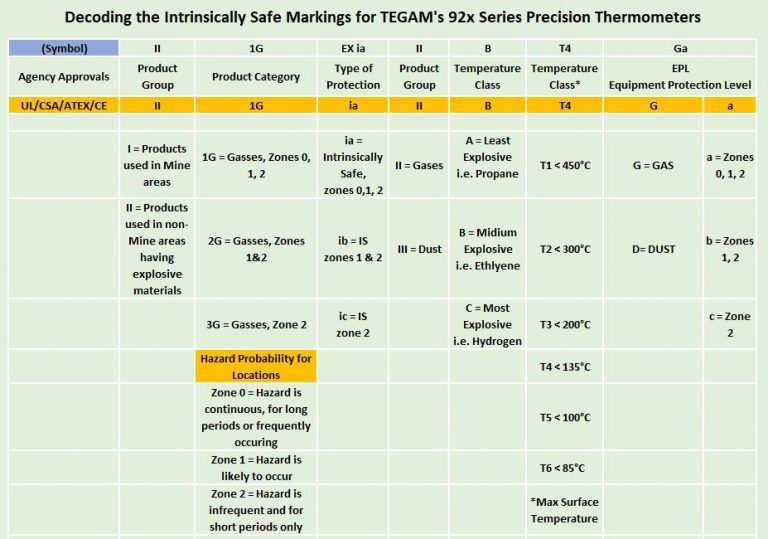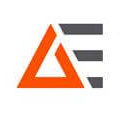Do You Need An Intrinsically Safe Digital Thermometer?
投稿 4月 19, 2019 によって Advanced Energy Editor
.jpg)
Is there a hazardous location in your manufacturing or production facility? Many industrial locations actually do have hazardous locations within them.
Intrinsic Safety is a means of preventing an explosion by designing instruments so that in any normal use or a fault condition, the instrumentation cannot produce enough energy to cause ignition or combustion of the substances within their ratings. The safety rating breaks down areas based upon whether the hazard is a Gas, Vapor or Dust. Then these ratings break down into zones which designate whether the hazard is present all the time (Zone 0), where the hazard is likely to occur (Zone 1), or to occur infrequently (Zone 2). Then, finally, into a temperature rating which indicates the highest temperature the casing (or part) may reach safely.
There are many industries that can have hazardous areas or zones within their facilities. Some plants have large hazardous areas, while some have only small parts classified as hazardous areas. Each room, section of a building or area should be considered separately in determining its classification. Typical industries with hazardous zones include chemical and petrochemical industries, offshore and onshore oil and gas, oil refining, pharmaceutical production, food and beverage production, energy production, paint shops, and mining operations.
Hazardous (classified) locations may be found in locations such as aircraft hangars, gasoline dispensing and service stations, bulk storage plants for gasoline or other volatile flammable liquids, paint-finishing process plants, health care facilities, laboratories, agricultural facilities or other facilities where excessive combustible fumes or dusts may be present. Also, marinas, boat yards, and petroleum and chemical processing plants can have hazardous areas within their confines.
Remember that the flammable substance may be a liquid, gas, vapor, or a dust, so there are surprisingly many different industries with regions where these substances may be present during normal operation or during a shutdown. Even some seemingly safe industries may have hazardous areas!
As a precaution, many facilities that have only a small hazardous area often require that all portable instruments in the facilities be intrinsically safe to assure the safety of the entire plant.
Typical Uses/Users of Intrinsically Safe Instruments (Digital Thermometers and More)
- Field Support for Petro-Chemical Industry
- Government: state agencies that monitor gas stations (Bureau of Weights and measures)
- Aircraft Manufacturing: once the plane or helicopter is fueled from production, it is considered a Hazardous Location for all further testing.
- All Petrochemical Plants
- Rail Road/Transportation: before a rail tanker car can be loaded, its temperature needs to be taken. Also, custody transfer via RR or at a Marine terminal.
- Grain Silos: grain dust is considered explosive and requires Intrinsically Safe products rated for Dust.
- Grain Product Manufacturing: same handling issues as grain silos.
- Large Breweries which handle a lot of grain and alcohol
- Distilleries also may have alcohol fumes present
- Marine Transfer Operations require all instruments to be IS (even 2-way radios)
- Health Care/Hospitals in USA
- Industrial Plants, Oil and Gas Refineries, Offshore Oilfield Equipment and Services, the Chemical Industry
- Anyone operating electrical equipment in a hazardous location: including Oil & Gas, Refinery, Chemical, On Shore and Offshore Oil, Power, Mining
The TEGAM 920 Series Intrinsically Safe precision digital thermometers are rated for use with gases in Zones 0, 1 and 2 – with a T4 temperature rating which includes all but the highest explosive gasses, such as hydrogen.
Below is a summary (not a complete or exhaustive list) of manufacturing sites and industries where intrinsically safe instruments may be required and could be recommended.
- Agriculture
- Aircraft Hangers
- Aircraft Maintenance Facilities
- Aircraft Manufacturing Locations
- Automotive Manufacturing
- Breweries and Distilleries
- Chemical Plants
- Custody Transfer
- Energy Generation
- Engine Testing Areas
- Food and Beverage Facilities
- Fuel Storage
- Fueling Locations
- Gasoline Bulk Storage Facilities
- Gasoline Dispensing Locations
- Grain Storage – Dust
- Grain Transportation – Dust
- Granaries – Dust
- Government – Weights & Measures
- Health Care Facilities
- Pharmaceutical Manufacturing
- Infrastructure
- Marinas & Boatyards
- Manufacturing
- Mining
- Metals
- Oil & Gas
- Oil Refining
- Offshore Oil
- Onshore Oil
- Paint Manufacturers
- Paint Shops
- Petro-Chemical
- Power Generation
- Pulp & Paper
- Refineries
- Transportation
Is your interest piqued regarding intrinsically safe instrumentation such as thermometers and more for your manufacturing/production facility? As with all processes within Industry, it’s definitely better to be safe than sorry! Please reach-out to us with any questions or queries you may have on our Intrinsically Safe thermometers, measuring devices and other I.S. instruments.
You can also view our infographic here on Contact Vs. Infrared thermometers for more thermometer selection criteria. Please take a look at TEGAM intrinsically safe thermometers here. See other TEGAM intrinsically safe measurement equipment also.
